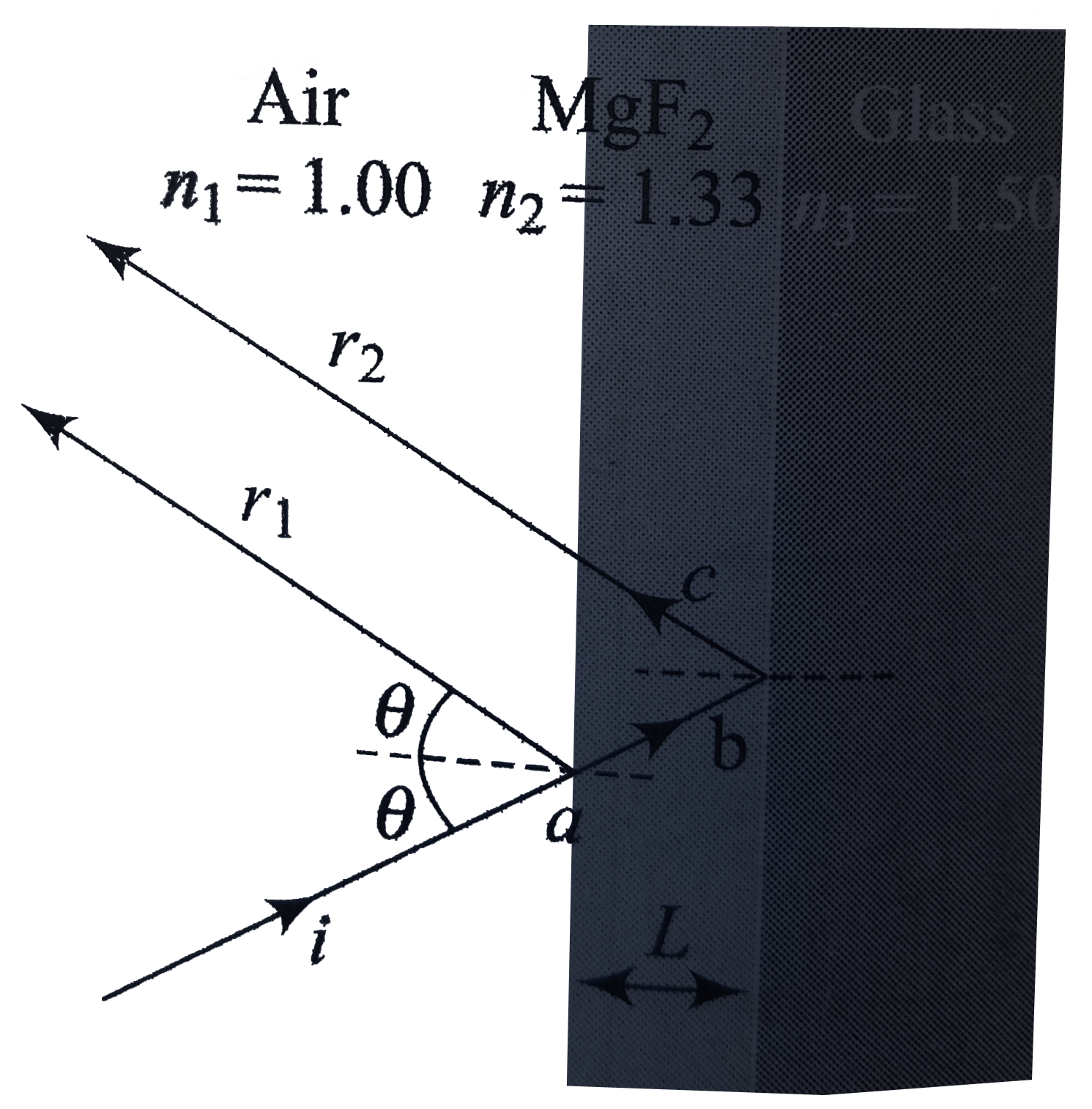A glass surface is coated by an oil film of uniform thickness 1.00×10−4cm. The index of refraction of the oil is 1.25 and that of the glass is 1.50. Find the wavelengths of light in the visible region (400nm-750nm) which are completely transmitted by the oil film under normal incidence.
The correct Answer is:A, D
To solve the problem, we need to determine the wavelengths of light in the visible region (400 nm to 750 nm) that are completely transmitted by an oil film of uniform thickness coated on a glass surface. The given parameters are:
- Thickness of the oil film, t=1.00×10−4 cm = 1.00×10−6 m
- Index of refraction of the oil, μ=1.25
- Index of refraction of the glass, ng=1.50
1. Understand the Condition for Strong Transmission:
For constructive interference (which leads to strong transmission) in thin films, the condition is given by:
2μt=(2n+1)λ2
where n is an integer (0, 1, 2, ...).
2. Rearranging the Formula:
We can rearrange the formula to solve for the wavelength λ:
λ=4μt2n+1
3. Substituting the Known Values:
Substitute μ=1.25 and t=1.00×10−6 m into the equation:
λ=4×1.25×1.00×10−62n+1
Simplifying this gives:
λ=5.00×10−62n+1 m
Converting to nanometers (1 m = 109 nm):
λ=5000 nm2n+1
4. Finding Values of n and Corresponding Wavelengths:
Now we will calculate λ for different integer values of n and check if they fall within the visible range (400 nm to 750 nm).
- For n=0:
λ=50001=5000 nm(not in visible range)
- For n=1:
λ=50003≈1666.67 nm(not in visible range)
- For n=2:
λ=50005=1000 nm(not in visible range)
- For n=3:
λ=50007≈714.29 nm(in visible range)
- For n=4:
λ=50009≈555.56 nm(in visible range)
- For n=5:
λ=500011≈454.55 nm(in visible range)
5. Final Result:
The wavelengths of light in the visible region that are completely transmitted by the oil film are:
- 714.29 nm
- 555.56 nm
- 454.55 nm
- Index of refraction of the oil, μ=1.25
- Index of refraction of the glass, ng=1.50
For constructive interference (which leads to strong transmission) in thin films, the condition is given by:
2μt=(2n+1)λ2
where n is an integer (0, 1, 2, ...).
We can rearrange the formula to solve for the wavelength λ:
λ=4μt2n+1
Substitute μ=1.25 and t=1.00×10−6 m into the equation:
λ=4×1.25×1.00×10−62n+1
Simplifying this gives:
λ=5.00×10−62n+1 m
Converting to nanometers (1 m = 109 nm):
λ=5000 nm2n+1
Now we will calculate λ for different integer values of n and check if they fall within the visible range (400 nm to 750 nm).
λ=50001=5000 nm(not in visible range)
- For n=1:
λ=50003≈1666.67 nm(not in visible range)
- For n=2:
λ=50005=1000 nm(not in visible range)
- For n=3:
λ=50007≈714.29 nm(in visible range)
- For n=4:
λ=50009≈555.56 nm(in visible range)
- For n=5:
λ=500011≈454.55 nm(in visible range)
The wavelengths of light in the visible region that are completely transmitted by the oil film are:
- 714.29 nm
- 555.56 nm
- 454.55 nm
Topper's Solved these Questions
- BOOK - HC VERMA ENGLISHCHAPTER - LIGHT WAVESEXERCISE - Question for short Answer11videos
LIGHT WAVES
- BOOK - HC VERMA ENGLISHCHAPTER - LIGHT WAVESEXERCISE - Objective -210videos
LIGHT WAVES
- BOOK - HC VERMA ENGLISHCHAPTER - GEOMETRICAL OPTICSEXERCISE - Question For short Answer18videos
GEOMETRICAL OPTICS
- BOOK - HC VERMA ENGLISHCHAPTER - MAGNETIC FIELDEXERCISE - objective29videos
MAGNETIC FIELD
Similar Questions
A parallel beam of white light is incident normally on a water film1.0x10−4 cm thick. Find the wavelength in the visible range (400 nm-700 nm) which are strongly transmitted by the film Refractive index of water = 1.33.
View SolutionWhite light is incident normally on a glass plate of thickness 0.50×10−6 and index of refraction 1.50. Which wavelength in the visible region (400 nm - 700 nm) are strongly reflacted by the plate ?
View SolutionWhen white light is incident normally an oil film of thickness 10−4cm and refractive index. 1.4 then the wavelength which will not be seen in the reflected system of light is
View SolutionWhite light is incident normally on a glass plate (in air) of thickness 500nm and refractive index of 1.5. The wavelength (in nm) in the visible region (400nm−700nm) that is strongly reflected by the plate is:
View SolutionIf the refractive index of glass is 1.5. Find the velocity of light in glass. (Velocity of light in vacuum =3×108m/s)
View SolutionBlue light of wavelength 480 nm is most strongly reflected off a thin film of oil on a glass slab when viewed near normal incidence. Assuming that the index of refraction of the oil is 1.2 and that of the glass is 1.6, what is the minimum thickness of the oil film (other then zero)?
View SolutionRefractive index of a thin soap film of a uniform thickness is 1.34. Find the smallest thickness of the film that gives in interference maximum in the reflected light when light of wavelength 5360Å fall at normal incidence.
View SolutionThe index of refraction of flised quartz is 1.472 for light of wavelength 400 nm and is 1.452 for light of wavelength 760 nm. Find the speeds of light of these wavelengths in fused quartz.
View SolutionA thin film of thickness t and index of refractive 1.33 coats a glass with index of refraction 1.50.What is the least thickness t that will strong reflect light with wavelength 600nm incident normally?
View SolutionA glass lens is coated on one side with a thin film of magnesium fluoride (MgF2)to reduce reflection from the lens surface (Fig. 2.26). The Index of refraction of MgF2 is 1.38, that of the glass is 1.50. What is the least coating thickness that eliminates (via interference) the reflections at the middle of the visible specturm (λ=550nm)? Assume that the light is approxmately perpendicular to the lens surface.
 View Solution
View Solution

